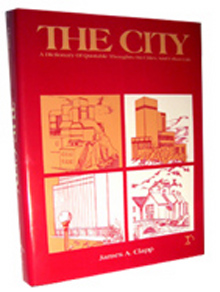Years ago, when I was researching my book on quotational thought on cities and urban life, I found some of the most clever and amusing material came from humorists. I decided to take some of the best of them and put them together for a radio essay, especially when a lot of the humorous rivalry that often exists between cities was given currency by the pennant race for the World Series between San Diego and Chicago. While the circumstances are dated, the humorous ripostes and barbs have a staying power. [By the way, this is not a shameless promotion of my book, which was published in 1984 and has been out of print for almost a decade. Then again, why didn’t you buy a copy when it was in print?]
 Rivalrous Cities
Rivalrous Cities
Rivalries among cities are commonplace, going back at least to Mycenae and Troy and doubtless a good deal earlier. Superior attitudes exhibited by Leningraders over Muscovites, Edinburgers over Glaswegians, and New Yorkers over Angelenos, among others, are longstanding and still the source of jokes and put downs. Los Angeles has been a staple for many East Coast comedians, among them Woody Allen, who, in his film Annie Hall jibes: “I don’t want to live in a city where the only cultural advantage is you can make a right turn on a red light.” Generally, such rivalries tend to express themselves in good-natured quips, as Charles Finger related of the sibling rivalry between two Midwestern sister cities: “One Sunday evening a Minneapolis minister started his sermon by saying, ‘I take my text this evening from St. Paul’; whereupon his congregation rose en masse and filed out of the church refusing to listen to any such doctrine.”
However, when the major league baseball teams of Chicago and San Diego confronted one another in a series of games to determine ascendancy to the World Series, the humorous insult contest between the cities, though not reaching the level of invective, did focus upon stereotypical class characteristics. San Diego, which is often characterized in the “laid-back” and narcissistic terms generally ascribed to Southern California, was portrayed by Chicago columnist Mike Royko as a “bunch of wimps” and “quiche-eaters” who absent themselves from work when the “surf’s up.” He went on to exclaim that: “Even their ballpark is disgusting. It’s new and modern and clean. And the fans wouldn’t even think of getting into brawls or cursing an opponent or tossing beer on an outfielder. Instead, they come to the park in the skimpiest clothing and admire each other’s Nautilus-tuned bods. Anybody with a manly, bleacher bum belly is viewed as an affront to the environment.”
Such a characterization is perhaps to be expected from a Chicago journalist whose town is typically portrayed in brawny, masculine terms by writers like Carl Sandburg, or Studs Terkel, who describes. . . “Chicago with its lack of sophistication and its muscularity [as] comical, archaic in this cool era, somewhat like an old punch-drunk fighter, swinging wild roundhouse wallops to the laughter of the weisenheimers at ringside.” An editorial in the San Diego Evening Tribune went right at that image: “Chicago is has-been slum of sausage-eaters on the toxic waste Riviera of America. It’s got a grand past in the corruption department.” Of the two cities, Chicago, perhaps owing to its more volatile past, tends to be more self-deprecating; even Sandburg, who penned a renowned poem about the city, was moved to joke: “Here is the difference between Dante, Milton and me. They wrote about hell without ever seeing the place. I wrote about Chicago after looking the town over for years and years.”
But some cities, faring so poorly in the rivalrous give-and-take, can ill-afford to poke much fun at themselves. “Oakland is this kind of town . . .” wrote sports columnist Jim Murray of the Los Angeles Times, “You have to pay 50 cents to go from Oakland to San Francisco. Coming to Oakland from San Francisco is free. And when you know that, it tells you all you have to know about Oakland. It has one of the longest losing streaks in the annals of American cities. It’s 0 for this century in municipal batting average.”
Oakland has the misfortune of juxtaposition to San Francisco, perennially voted in polls as “America’s favorite city.” Ironically, Oakland’s position as the butt of put-downs may have been originated by one of its most famous daughters, Gertrude Stein. It was Oakland’s ill-luck to be implicitly compared to another of the world’s favorite cities, which Stein adopted as her home after leaving her native city. She much preferred Paris because “the trouble with Oakland” as she saw it, was that: “. . .there is no there there.” The satirical barb invited a parody by San Francisco newspaper columnist Herb Caen: “The trouble with Oakland is that when you get there, it’s there!” Oaklanders have been vexed by these put-downs for years, finally prompting a defensive retort from among the city’s prouder residents that “there is a here, here.”
In the final analysis it is a city’s personality or image—a laid-back San Diego, tough Chicago, or a homely sister Oakland—that attracts and inspires the humorist. Most cities do not appear to mind the attention as long as, as the saying goes, “they spell its name right.” For the thinned-skinned city there is little chance for escape but to attempt to change its image. But even of that, warns columnist Art Seidenbaum: “A city worrying about image enhancement is like a man considering a wig; each faces the world with a shinning inferiority complex.”
___________________________________
©1987, ©2003, James A. Clapp (UrbisMedia Ltd. Pub. 12.5.2003)
Essay No. 6, Aired KPBS-FM, Public Radio, February 5, 1987
